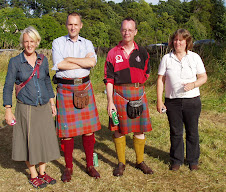The Negatives
Webster’s New International Dictionary of the English Language, 2nd Edition, 1935, unabridged, doesn’t include it. Webster’s is very good on phrases. That’s why I tend to believe that the phrase wasn’t in anything like the general use it is now, between the wars. And yes, I know, that’s the Argument from Silence again.
It’s not in the big Oxford English Dictionary of 1989. (I’ve got it on CD-ROM, Alexander’s gift.)
I wrote to Bishop Rutt in ’97. He wrote back at once, most helpfully, but he doesn’t know the answer. He says, “’Kitchener’ almost certainly comes from Lord Kitchener, and may have to do with knitting socks for soldiers – but why?” etc.
I wrote to Lord Kitchener in 1998. He replied, over a year later: “I must apologise for not having answered your letter about the ‘Kitchener stitch’. I have not heard of it before…”
The Positives
I don’t have the source for EZ’s statement that somebody wrote to her and explained that the phrase derives from a pattern Kitchener submitted to a Red Cross leaflet. I believe it appeared in Woolgathering, and if so could easily be tracked down through Meg. I know that EZ didn’t press the issue, or try to find the leaflet.
This brings us to the treasures Jayne sent me this week:
-- A scan of a Canadian Red Cross leaflet of 1940, with instructions for the “Kitchener toe”. An interesting and rather alarming aspect of this item is that the phrase could well apply to the method of decreasing for the toe, not to the finishing. You have 56 stitches for the foot. You knit a round consisting of k6, k2tog. You knit 5 plain rounds. You knit a round of k5, k2tog. You knit 4 plain rounds. And so forth, until 10 stitches remain. Then you graft them together. “For grafting, see page 28.” So a “Kitchener toe” might not refer to a grafted toe at all. Jayne, I don’t suppose “Kitchener” is mentioned on Page 28?
-- Jayne also searched the archives of the Toronto Star and the Globe and Mail. She found this, in a question-and-answer column of the Star for January 28, 1930:
“Dear Esther Roberts:
Can you please tell me how to knit a Kitchener toe for sox ? C.D.
I am sorry, but I haven’t the directions for knitting a Kitchener toe. Perhaps one of the readers will be able to give it to us. We all used to have it during the war, didn’t we ?”
That seems to me interesting on a couple of fronts. The date, to begin with. The fact that the “Kitchener toe” is not well-known (assuming, for the moment, that we are talking about grafting). And most of all, the reference to “the war”.
Comments
Mundi, I was delighted to have your first-hand memory of being taught the “Kitchener toe”. Your aunt was probably born around the end of the Great War (given that she is in her 80’s now), and must have learned the technique herself from someone whose experience of knitting went back before the war.
Tamar, yes, my Paton’s book, “Collection of Knitting and Crochet Receipts”, is dated 1908. It says of “grafting” on the Rules and Explanations page: “This stitch, the knowledge and practical use of which is invaluable, is taught in every elementary school…”
Taken together with “Esther Roberts’” ignorance, see above, this could well imply that grafting was in wider use on this side of the Atlantic. Maybe Lord Kitchener’s pattern was something of a revelation in Canada when it appeared.
I have heard the idea you mention, that the phrase comes from the town of Kitchener, Ontario. I am less attracted to the idea, but it must be kept in mind.
We’re getting close! I hope to draft a note to the Canadian Red Cross soon. (I am miles dot jean at googlemail dot com.)
Subscribe to:
Post Comments (Atom)



No comments:
Post a Comment